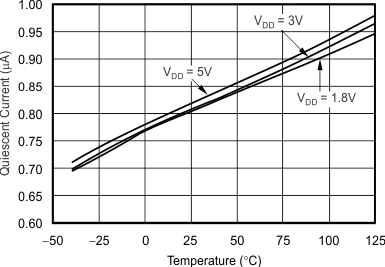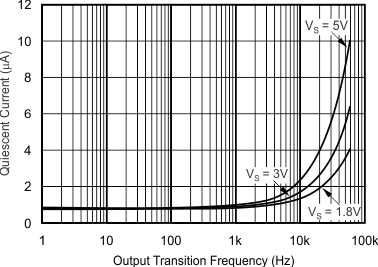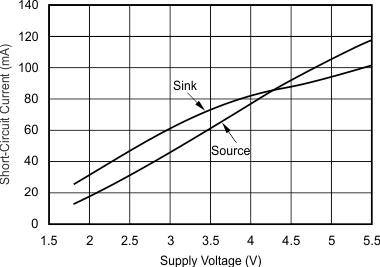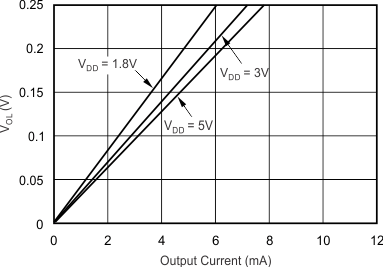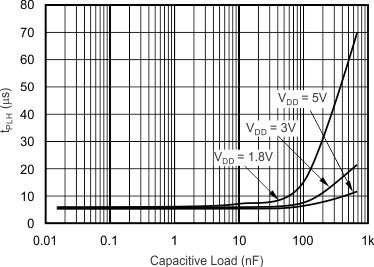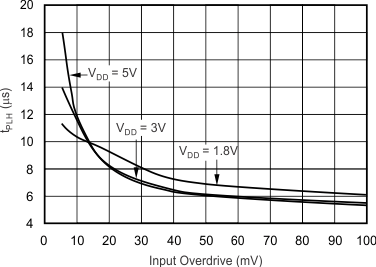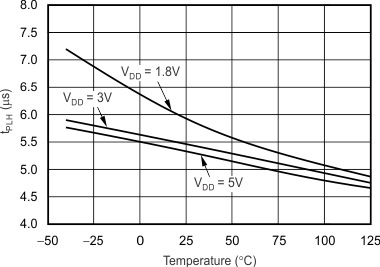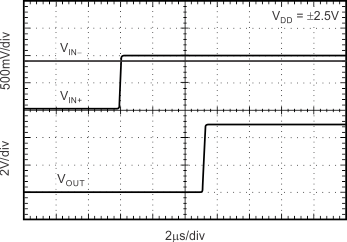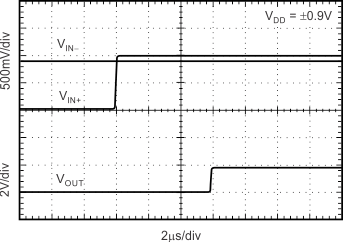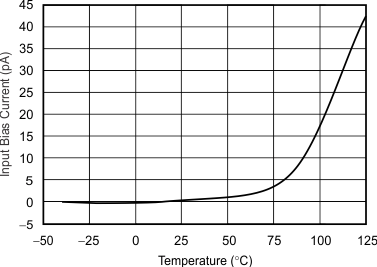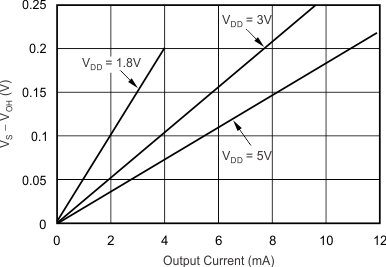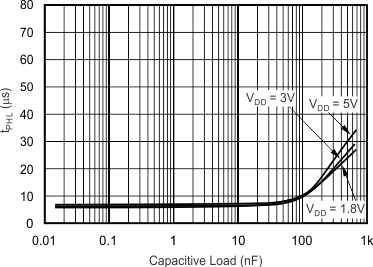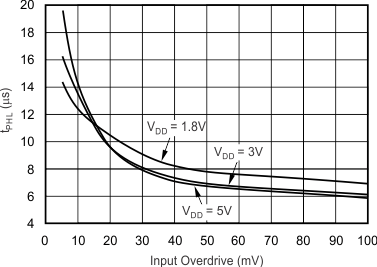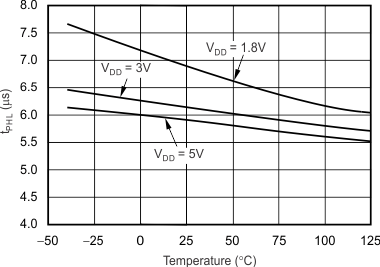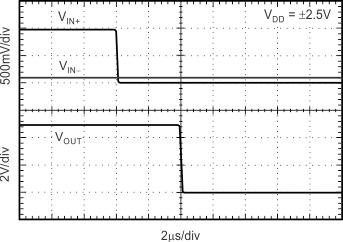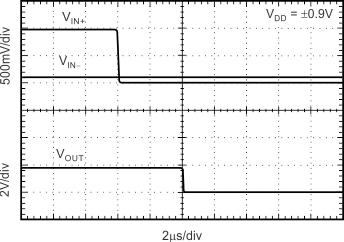SBOS262E December 2002 – December 2016 TLV3491 , TLV3492 , TLV3494
PRODUCTION DATA.
- 1 Features
- 2 Applications
- 3 Description
- 4 Revision History
- 5 Device Comparison Table
- 6 Pin Configuration and Functions
- 7 Specifications
- 8 Detailed Description
- 9 Application and Implementation
- 10Power Supply Recommendations
- 11Layout
- 12Device and Documentation Support
- 13Mechanical, Packaging, and Orderable Information
Package Options
Mechanical Data (Package|Pins)
Thermal pad, mechanical data (Package|Pins)
- DCN|8
Orderable Information
7 Specifications
7.1 Absolute Maximum Ratings
over operating free-air temperature range (unless otherwise noted)(1)| MIN | MAX | UNIT | ||
|---|---|---|---|---|
| Voltage | Supply | 5.5 | V | |
| Signal input pin | (V–) – 0.5 | (V+) + 0.5 | V | |
| Current | Signal input pin | –10 | 10 | mA |
| Output short circuit | Continuous | |||
| Temperature | Operating, TA | –40 | 125 | °C |
| Junction, TJ | 150 | °C | ||
| Storage, Tstg | –65 | 150 | °C | |
(1) Stresses beyond those listed under Absolute Maximum Ratings may cause permanent damage to the device. These are stress ratings only, which do not imply functional operation of the device at these or any other conditions beyond those indicated under Recommended Operating Conditions. Exposure to absolute-maximum-rated conditions for extended periods may affect device reliability.
7.2 ESD Ratings
| VALUE | UNIT | |||
|---|---|---|---|---|
| V(ESD) | Electrostatic discharge | Human-body model (HBM), per ANSI/ESDA/JEDEC JS-001(1) | ±3000 | V |
(1) JEDEC document JEP155 states that 500-V HBM allows safe manufacturing with a standard ESD control process.
7.3 Recommended Operating Conditions
over operating free-air temperature range (unless otherwise noted)| MIN | MAX | UNIT | ||
|---|---|---|---|---|
| Supply voltage | 1.8 | 5.5 | V | |
| TA | Specified temperature | –40 | 125 | °C |
7.4 Thermal Information: TLV3491
| THERMAL METRIC(1) | TLV3491 | UNIT | ||
|---|---|---|---|---|
| DBV (SOT-23) | D (SOIC) | |||
| 5 PINS | 8 PINS | |||
| RθJA | Junction-to-ambient thermal resistance | 237.8 | 201.9 | °C/W |
| RθJC(top) | Junction-to-case (top) thermal resistance | 108.7 | 92.5 | °C/W |
| RθJB | Junction-to-board thermal resistance | 64.1 | 123.3 | °C/W |
| ψJT | Junction-to-top characterization parameter | 12.1 | 23 | °C/W |
| ψJB | Junction-to-board characterization parameter | 63.3 | 212.6 | °C/W |
| RθJC(bot) | Junction-to-case (bottom) thermal resistance | — | — | °C/W |
(1) For more information about traditional and new thermal metrics, see the Semiconductor and IC Package Thermal Metrics application report.
7.5 Thermal Information: TLV3492
| THERMAL METRIC(1) | TLV3492 | UNIT | ||
|---|---|---|---|---|
| DCN (SOT-23) | D (SOIC) | |||
| 8 PINS | 8 PINS | |||
| RθJA | Junction-to-ambient thermal resistance | 135.4 | 201.9 | °C/W |
| RθJC(top) | Junction-to-case (top) thermal resistance | 68.1 | 92.5 | °C/W |
| RθJB | Junction-to-board thermal resistance | 48.9 | 123.3 | °C/W |
| ψJT | Junction-to-top characterization parameter | 9.9 | 23 | °C/W |
| ψJB | Junction-to-board characterization parameter | 48.4 | 212.6 | °C/W |
| RθJC(bot) | Junction-to-case (bottom) thermal resistance | — | — | °C/W |
(1) For more information about traditional and new thermal metrics, see the Semiconductor and IC Package Thermal Metrics application report.
7.6 Thermal Information: TLV3494
| THERMAL METRIC(1) | TLV3494 | UNIT | ||
|---|---|---|---|---|
| D (SOIC) | PW (TSSOP) | |||
| 14 PINS | 14 PINS | |||
| RθJA | Junction-to-ambient thermal resistance | 83.8 | 120.8 | °C/W |
| RθJC(top) | Junction-to-case (top) thermal resistance | 70.7 | 34.3 | °C/W |
| RθJB | Junction-to-board thermal resistance | 59.5 | 62.8 | °C/W |
| ψJT | Junction-to-top characterization parameter | 11.6 | 1 | °C/W |
| ψJB | Junction-to-board characterization parameter | 37.7 | 56.5 | °C/W |
| RθJC(bot) | Junction-to-case (bottom) thermal resistance | — | — | °C/W |
(1) For more information about traditional and new thermal metrics, see the Semiconductor and IC Package Thermal Metrics application report.
7.7 Electrical Characteristics: VS = 1.8 V to 5.5 V
at TA = 25°C and VS = 1.8 V to 5.5 V (unless otherwise noted)| PARAMETER | TEST CONDITIONS | MIN | TYP | MAX | UNIT | ||
|---|---|---|---|---|---|---|---|
| OFFSET VOLTAGE | |||||||
| VOS | Input offset voltage | TA = 25°C, VCM = 0 V, IO = 0 V | ±3 | ±15 | mV | ||
| dVOS/dT | Input offset voltage versus temperature | TA = –40°C to 125°C | ±12 | µV/°C | |||
| PSRR | Input offset voltage versus power supply | VS = 1.8 V to 5.5 V | 350 | 1000 | µV/V | ||
| INPUT BIAS CURRENT | |||||||
| IB | Input bias current | VCM = VCC/2 | ±1 | ±10 | pA | ||
| IOS | Input offset current | VCM = VCC/2 | ±1 | ±10 | pA | ||
| INPUT VOLTAGE | |||||||
| VCM | Common-mode voltage | (V–) – 0.2 V | (V+) + 0.2 V | V | |||
| CMRR | Common-mode rejection ratio | VCM = –0.2 V to (V+) – 1.5 V | 60 | 74 | dB | ||
| VCM = –0.2 V to (V+) + 0.2 V | 54 | 62 | |||||
| INPUT CAPACITANCE | |||||||
| Common-mode | 2 | pF | |||||
| Differential | 4 | pF | |||||
| OUTPUT (VS = 5 V) | |||||||
| VOH | Voltage output high from rail | IOUT = 5 mA | 90 | 200 | mV | ||
| VOL | Voltage output low from rail | IOUT = 5 mA | 160 | 200 | mV | ||
| ISC | Short-circuit current | See Typical Characteristics | |||||
| POWER SUPPLY | |||||||
| VS | Specified voltage | 1.8 | 5.5 | V | |||
| Operating voltage | 1.8 | 5.5 | V | ||||
| IQ | Quiescent current(1) | VO = 5 V, VO = high | 0.85 | 1.2 | µA | ||
(1) IQ per channel
7.8 Switching Characteristics
at f = 10 kHz, VSTEP = 1 V, TA = 25°C, and VS = 1.8 V to 5.5 V (unless otherwise noted)| PARAMETER | TEST CONDITIONS | MIN | TYP | MAX | UNIT | |
|---|---|---|---|---|---|---|
| t(PLH) | Propagation delay time, low-to-high | Input overdrive = 10 mV | 12 | µs | ||
| Input overdrive = 100 mV | 6 | |||||
| t(PLH) | Propagation delay time, high-to-low | Input overdrive = 10 mV | 13.5 | µs | ||
| Input overdrive = 100 mV | 6.5 | |||||
| tR | Rise time | CL = 10 pF | 100 | ns | ||
| tF | Fall time | CL = 10 pF | 100 | ns | ||
7.9 Typical Characteristics
at TA = 25°C, VS = 1.8 V to 5.5 V, and input overdrive = 100 mV (unless otherwise noted)